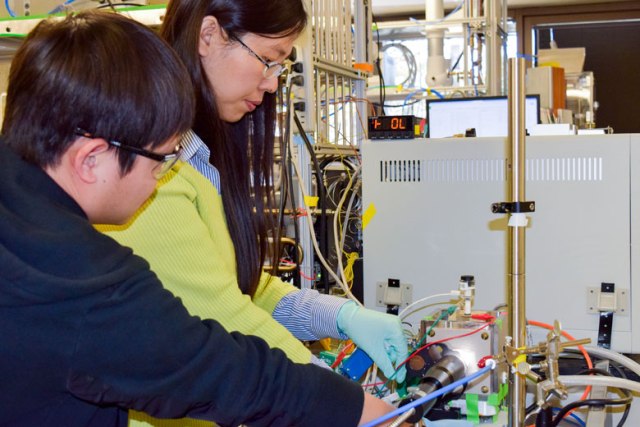Feb 26 2016
An economy that depends solely on fossil fuels seems unsustainable in the current global scenario. Oil prices are crashing, and supplies of coal, oil, and similar fuels are limited.
 Graduate student Xiaofei Ye (left) helps postdoctoral scholar Liming Zhang adjust an experimental device that, confounding conventional wisdom, showed that heating metal oxide solar cells increased their efficiency. (Photo Credit: Tom Abate)
Graduate student Xiaofei Ye (left) helps postdoctoral scholar Liming Zhang adjust an experimental device that, confounding conventional wisdom, showed that heating metal oxide solar cells increased their efficiency. (Photo Credit: Tom Abate)
The situation is complicated further with the rising issues related to global warming. The leading solution is limitless solar power, however there is the issue of storing and supplying solar energy when sunlight is not available.
According to energy experts solar power has to be made "dispatchable" by engineers, meaning the it requires the ability to increase or decrease power output based on demand. Recently a team of researchers headed by William Chueh, an assistant professor of materials science and engineering, and Nicholas Melosh, an associate professor in the same department, have made a breakthrough which may make large-scale storage of solar power a reality.
The team discovered that common metal oxides, such as rust, can be used to form solar cells that can split water into oxygen and hydrogen. Using solar cells to split H2O by day is one method to store energy to use at night. The photons trapped by the cell are converted into the electrons, which supply the energy to split water.
Energy can be reclaimed by recombining oxygen and hydrogen at night. Then it can be "dispatched" back into the electrical grid. No fossil fuels need to be burnt and no excess carbon is released into the atmosphere.
The concept of metal oxides possessing solar power potential was already known However compared to silicon solar cells, metal oxide solar cells were also identified as being less efficient at converting photons to electrons.
A report in the Energy & Environmental Science journal stated that metal oxide solar cells were a better option for energy storage. The Stanford team illustrated that when the metal oxide solar cells grew hotter, they tend to convert photons into electrons in a more efficient manner. It is exactly the opposite with silicon solar cells, which tend to lose efficiency as the heat increases.
This unanticipated breakthrough may pave the way for a radical change in the way energy is produced, stored, and consumed.
We've shown that inexpensive, abundant and readily processed metal oxides could become better producers of electricity than was previously supposed. By combining heat and light, solar water-splitting cells based on metal oxides become significantly more efficient at storing the inexhaustible power of the sun for use on demand.
William Chueh, Assistant Professor of Materials Science and Engineering, Stanford University
Until now it has been unfeasible to utilize water-splitting as a method to store solar energy, as cost was an issue. Silicon-based solar cells, which are used in rooftop solar arrays, are suitable to convert visible and UV light into electricity. The downside is that silicon cells waste the infrared light, which bears the heat, falling upon it.
Standard cells utilize a relatively small portion of the spectrum, and the rest is lost as heat.
William Chueh, Assistant Professor of Materials Science and Engineering, Stanford University
Until the Stanford discovery, metal oxides were thought to be less efficient when they became hotter. Another reason it was not considered was due to the fact that they were less efficient compared to silicon, which made them unappealing as a water-splitting technology.
This misconception was rectified by the experiments conducted by the Stanford team. They worked with three metal oxides- titanium oxide, iron oxide (which is generally known as rust), and bismuth vanadium oxide. They tested the efficiencies of these oxides to convert photons to electrons, and splitting water into oxygen and hydrogen at varying temperatures.
In all three cases we observed increased production of hydrogen and oxygen at higher temperatures. We realized that the higher temperatures were enhancing the carrier mobility of these cells – the speed at which electrons can pass through the metal oxides.
Liming Zhang, Postdoctoral Scholar, Stanford University
Xiaofei Ye, the other co-lead author of the paper, stated that the increase in efficiency was extraordinary.
Our results shows that heating up metal oxides with sunlight can double rate of hydrogen generation.
Xiaofei Ye, Co-Author
Out of the three oxides that were tested, bismuth vanadium oxide was the most efficient. However the team believe that the heat-enhancing effect could work for many different metal oxides. Going forward they will be experimenting on other materials, which were considered to be unfeasible materials for solar cells.
We'll also be looking for those temperature sweet spots where performance is optimized.
Madhur Boloor, Graduate Student
The fact that heating metal oxides generates additional energy means that comparatively simple engineering could be used to heat these solar cells to optimize their efficiency.
You don't have to add energy from an outside source. You can do it for free by concentrating solar radiation, either through a magnifying lens or parabolic mirrors.
Andrey Poletayev, Graduate Student
Chueh believes that this breakthrough will attract interest to develop metal oxides as economical replacements to silicon solar cells. He predicts that pure hydrogen gas created using water-splitting technology could be applied directly to power vehicles or other machines without causing pollution.
We can store these gases, we can transport them through pipelines, and when we burn them we don't release any extra carbon. It's a carbon-neutral energy cycle.
William Chueh, Assistant Professor of Materials Science and Engineering, Stanford University
Stanford's Global Climate and Energy Project and the National Science Foundation supported the research.